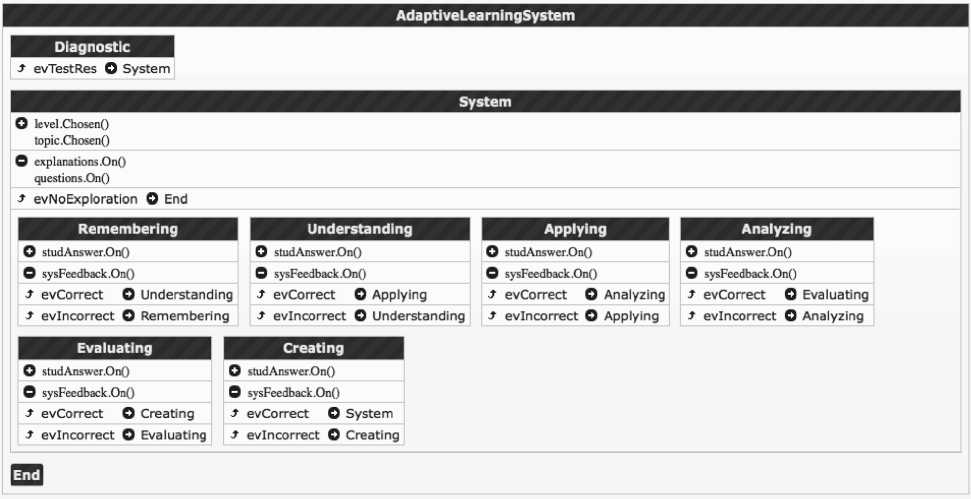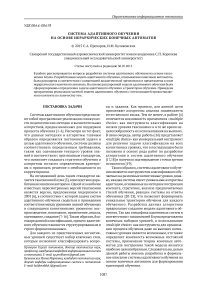Система адаптивного обучения на основе иерархических конечных автоматов
Автор: Прохоров Сергей Антонович, Куликовских Илона Марковна
Журнал: Известия Самарского научного центра Российской академии наук @izvestiya-ssc
Рубрика: Перспективные информационные технологии
Статья в выпуске: 2-5 т.17, 2015 года.
Бесплатный доступ
В работе рассматриваются вопросы разработки системы адаптивного обучения на основе таксономии Блума. Разработанная модель адаптивного обучения, описываемая конечным автоматом, была расширена в соответствии с концепцией дидактической эргономики и представлена в виде иерархического конечного автомата. На основе расширенной модели адаптивного обучения были сформулированы определения задачи адаптивного обучения и траектории обучения. Приведена программная реализация частной модели адаптивного обучения с оптимизацией предоставляемого контента по количеству тем.
Адаптивное обучение, иерархический конечный автомат, таксономия блума, когнитивный уровень, траектория обучения
Короткий адрес: https://sciup.org/148203709
IDR: 148203709 | УДК: 004.4:
Текст научной статьи Система адаптивного обучения на основе иерархических конечных автоматов
Как отмечалось ранее, данное исследование направлено на рассмотрение задачи адаптивного обучения с оптимизацией контента по количеству тем. С этой целью, разработанная модель (2) была реализована программно с помощью пакета StateForge . На рис. 2 приведена диаграмма представленного иерархического автомата. Следует отметить, что состояния автомата соответствуют когнитивным уровням версии таксономии Блума, предложенной Андерсоном [6].
xmlns:xsi=” XMLSchema-instance” xsi:schemaLocation=”http://www. ”>
< !-- General settings -->
“false” namespace=”com. stateforge.statemachine.examples. AdaptiveLearningSystem”>
< !-- Events -->
< !-- States -->
Рис. 2.
Диаграмма иерархического конечного автомата, реализованного в StateForge

ВЫВОДЫ
В рамках проведенного исследования была поставлена и формализована задача адаптивного обучения, базирующаяся на таксономии Блума и теории конечных автоматов. Созданная модель была расширена согласно концепции дидактической эргономики, учитывающей характеристики C и атрибуты A , а также педагогические стратегии и тактики. Расширенная модель была представлена в виде иерархического конечного автомата, на основе которого даны определения задачи адаптивного обучения. Приведена программная реализация частной модели адаптивного обучения с оптимизацией предоставляемого контента A 1 J e A по количеству тем J .
На данном этапе исследований разработанная система адаптивного обучения воспринимает U – ответы обучаемого – лишь как события, поступающие на вход, таким образом, дальнейшее направление развития данной работы связано с реализацией асинхронного автомата, который учитывает отношения C → A и A → C , а также c проведением экспериментальных исследований.
ФИНАНСИРОВАНИЕ
Работа выполнена при государственной поддержке Министерства образования и науки РФ в рамках реализации мероприятий Программы повышения конкурентоспособности СГАУ среди ве- дущих мировых научно-образовательных центров на 2013-2020 годы.
Список литературы Система адаптивного обучения на основе иерархических конечных автоматов
- Intelligent tutoring systems: formalization as automata and interface design using neural networks/S.G. Curilem, A.R. Barbosa, F.M. Azevedo//Computers & Education. 2007. Vol. 49. P. 545-561.
- Automatic generation of just-in-time online assessments from software design models/I.A. Zualkernan, S.A. El-Naaj, M. Papadopoulos, B.K. Al-Amoudi, C.E. Metthews//Educational Technology & Society. 2009. Vol. 1. № 12. P. 173-192.
- Designing and developing software for educative virtual laboratories with language processing techniques: lessons learned in practical experiments/J.J. Castro, M.A. Redondo, J. Gallardo, F. Jurado//Journal of Research and Practice in Information Technology. 2012. Vol. 44, № 3. -P. 289-308.
- Riechert R., Hartmann W. On the learning in e-learning//The proceedings of World Conference on Education, Multimedia, Hypermedia and Telecommunication. 2004. P. 1590-1595.
- Taxonomy of educational objectives: The classification of educational goals. Handbook 1: Cognitive domain/B.S. Bloom (Ed.), M.D. Engelhart, E.J. Furst, W.H. Hill, D.R. Krathwohl. New York: David McKay, 1956. 207 p.
- A taxonomy for learning, teaching, and assessing: A revision of Bloom's Taxonomy of Educational Objectives/L.W. Anderson (Ed.), D.R. Krathwohl (Ed.), P.W. Airasian, K.A. Cruikshank, R.E. Mayer, P.R. Pintrich, J. Raths, M.C. Wittrock. New York: Longman, 2001. 336 p.
- Hashim K., Khairuddin N.N. Software engineering assessments and learning outcomes/K. Hashim,//The proceedings of the 8th WSEAS Int. Conference on Software Engineering, Parallel and Distributed Systems. 2009. P. 131-134.
- Bloom’s taxonomy revised: specifying assessable learning objectives in computer science/C.W. Starr, B. Manaris, R.H. Stalvey//The proceedings of the 39th SIGSCE Technical Symposium on Computer Science Education. 2008. P. 261-265.
- Automated analysis of exam questions according to Bloom’s taxonomy/N. Omar, S.S. Haris, R. Hassan, H. Arshad, M. Rahmat, N.F.A. Zainal, R. Zulkifli//Procedia -Social and Behavioral Sciences. 2012. Vol. 59. P. 297-303.
- Mayer R.E. A taxonomy for computer-based assessment of problem-solving//Computers in Human Behaviour. 2002. Vol. 18. P. 623-632.
- Terzis V., Economides A.A. The acceptance and use of computer based assessment//Computers & Education. 2011. Vol. 56. -P. 1032-1044.
- Implementing computer-based assessment -A web-based mock examination changes attitudes/T. Deutsch, K. Herrmann, T. Frese, H. Sandholzer//Computers & Education. 2012. Vol. 55. P. 1068-1075.
- Kuo C.-Y., Wu H.-K. Toward an integrated model for designing assessment systems: An analysis of the current status of computer-based assessment in science//Computers & Education. 2013. Vol. 68. -P. 388-403.
- Wang T.-H. Developing an assessment-centered e-learning system for improving student learning effectiveness//Computers & Education. 2014. Vol. 73. -P. 189-203.
- Problem solving learning environments and assessment: a knowledge space theory approach/P. Reimann, M. Kickmeier-Rust, D. Albeert//Computers & Education. 2013. Vol. 64. P. 183-193.
- Thelwall M. Computer-based assessment: a versatile educational tool//Computers & Education. 2000. Vol. 34. P. 37-49.
- Comparison of examination methods based on multiple-choice questions and constructed-response questions using personal computers/E. Ventouras, D. Triantis, P. Tsiakas, C. Stergiopoulos//Computers & Education. 2010. Vol. 54. P. 455-461.
- Visual attention for solving multiple-choice science problem: An eye-tracking analysis/M.-J. Tsai, H.-T. Hou, M.-L. Lai, W.-Y. Liu, F.-Y. Yang//Computers & Education. 2012. Vol. 58. P. 375-385.
- Espinosa M.P., Gardeazabal J. Optimal correction for guessing in multiple-choice tests//Journal of Mathematical Psychology. 2010. Vol. 54. P. 415-425.
- Effects of feedback in a computer-based assessment for learning/F.M. Kleij, T.J.H.M. Eggen, C.F. Timmers, B.P. Veldkamp//Computers & Education. 2012. Vol. 58. P. 263-272.
- Formative assessment and feedback: Making learning visible/A. Havnes, K. Smith, O. Dysthe, K. Ludvigsen//Studies in Educational Evaluation. 2012. Vol. 38. P. 21-27.
- Timmers C., Veldkamp B. Attention paid to feedback provided by a computer-based assessment for learning on information literacy/C. Timmers,//Computers & Education. 2011. Vol. 56. P. 923-930.
- Exploring feedback and student characteristics relevant for personalizing feedback strategies/S. Narciss, S. Sosnovsky, L. Schnaubert, E. Andres, A. Eichelmann, G. Goguadze, E. Melis//Computers & Education. 2014. Vol. 71. P. 56-76.
- Computers and education. Towards a lifelong learning society/M. Liamas, M.J. Fernández-Iglesias, L.E. Anido-Rifon (Eds). Netherlands: Springer, 2006. 287 p.
- Кузьмин Е.В. Иерархическая модель автоматных программ//Моделирование и анализ информационных систем. -2006. Т. 13, № 1. С. 27-34.
- Lemch E.S., Caines P.E. On the existence of hybrid models for finite state machines//Systems & Control Letters. 1999. Vol. 36. P. 253-259.
- Spinke V. An object-oriented implementation of concurrent and hierarchical state machines//Information and Software Technology. 2013. Vol. 55. P. 1726-1740.


